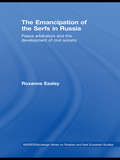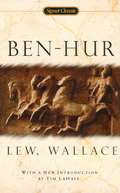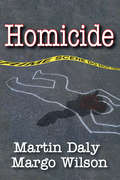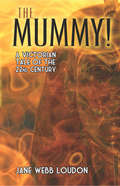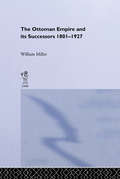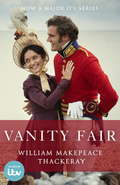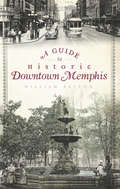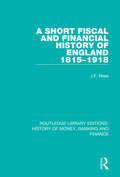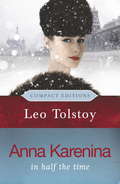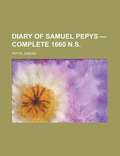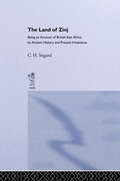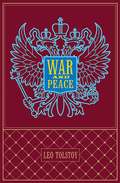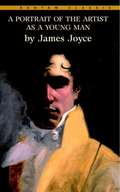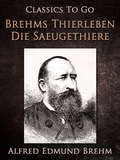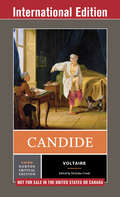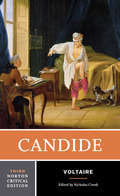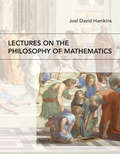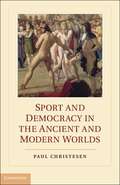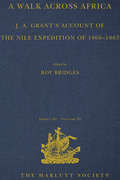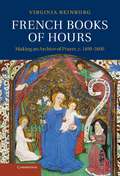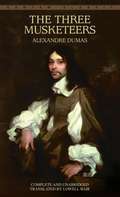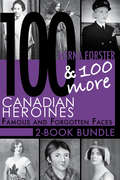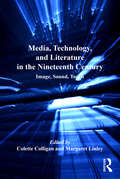- Table View
- List View
The Emancipation of the Serfs in Russia: Peace Arbitrators and the Development of Civil Society (BASEES/Routledge Series on Russian and East European Studies #Vol. 50)
by Roxanne EasleyIn the wake of the disastrous Crimean War, the Russian autocracy completely renovated its most basic social, political and economic systems by emancipating some 23 million privately-owned serfs. This had enormous consequences for all aspects of Russian life, and profound effects on the course of Russian history. This book examines the emancipation of the serfs, focusing on the mechanisms used to enact the reforms and the implications for Russian politics and society in the long term. Because the autocracy lacked the necessary resources for the reform, it created new institutions with real powers and autonomy, particularly the mirovoi posrednik, or 'peace arbitrator'. The results of this strategy differed in practice from the authorities’ original intentions. The new institutions invigorated Russian political life, introduced norms that challenged centuries-old customs and traditions, and fostered a nascent civil society, allowing Russia to follow the basic trajectory of Western European socio-political development.
Ben-Hur
by Lew WallacePurchase of this book includes free trial access to www. million-books. com where you can read more than a million books for free. This is an OCR edition with typos. Excerpt from book: faced each other. Simultaneously their heads bent forward, their hands crossed upon their breasts, and, speaking together, they said aloud this simple grace: Father of all?God ?what we have here is of thee; take our thanks and bless us, that we may continue to do thy will. With the last word they raised their eyes, and looked at each other in wonder. Each had spoken in a language never before heard by the others; yet each understood perfectly what was said. Their souls thrilled with divine emotion; for by the miracle they recognized the Divine Presence. CHAPTER III. To speak in the style of the period, the meeting just described took place in the year of Rome 747. The month was December, and winter reigned over all the regions east of the Mediterranean. Such as ride upon the desert in this season go not far until smitten with a keen appetite. The company under the little tent were not exceptions to the rule. They were hungry, and ate heartily; and, after the wine, they talked. To a wayfarer in a strange land nothing is so sweet as to hear his name on the tongue of a friend, said the Egyptian, who assumed to be president of the repast. Before us lie many days of companionship. It is time we knew each other. So, if it be agreeable, he who came last shall be first to speak. Then, slowly at first, like one watchful of himself, the Greek began: What I have to tell, my brethren, is so strange that I hardly know where to begin or what I may with propriety speak. I do not yet understand myself. The most I am sure of is that I am doing a Master's will, and that the service is a constant ecstasy. When I think of the purpose I am sent to fulfil, there is in me a joy so inexpressible that I know the will is God's. The good man paused, unable to proceed, while t. . .
Homicide: Foundations of Human Behavior (Foundations of Human Behavior)
by Martin Daly Margo WilsonThe human race spends a disproportionate amount of attention, money, and expertise in solving, trying, and reporting homicides, as compared to other social problems. The public avidly consumes accounts of real-life homicide cases, and murder fiction is more popular still. Nevertheless, we have only the most rudimentary scientific understanding of who is likely to kill whom and why. Martin Daly and Margo Wilson apply contemporary evolutionary theory to analysis of human motives and perceptions of self-interest, considering where and why individual interests conflict, using well-documented murder cases. This book attempts to understand normal social motives in murder as products of the process of evolution by natural selection. They note that the implications for psychology are many and profound, touching on such matters as parental affection and rejection, sibling rivalry, sex differences in interests and inclinations, social comparison and achievement motives, our sense of justice, lifespan developmental changes in attitudes, and the phenomenology of the self. This is the first volume of its kind to analyze homicides in the light of a theory of interpersonal conflict. Before this study, no one had compared an observed distribution of victim-killer relationships to "expected" distribution, nor asked about the patterns of killer-victim age disparities in familial killings. This evolutionary psychological approach affords a deeper view and understanding of homicidal violence.
The Mummy!: A Victorian Tale of the 22nd Century
by Jane Webb LoudonWithin a decade of the 1818 publication of Mary Shelley's Frankenstein, another Englishwoman invented a foundational work of science fiction. Seventeen-year-old Jane Webb Loudon took up the theme of reanimation, moved it three hundred years into the future, and applied it to Cheops, an ancient Egyptian mummy. Unlike Shelley's horrifying, death-dealing monster, this revivified creature bears the wisdom of the ages and is eager to share his insights with humanity. Cheops boards a hot-air balloon and travels to 22nd-century England, where he sets about remedying the ills of a corrupt government.In recounting Cheops' attempts to put the futuristic society to rights, the young author offers a fascinating portrait of the preoccupations of her own era as well as some remarkably prescient predictions of technological advances. The Mummy! envisions a world in which automatons perform surgery, undersea tunnels connect England and Ireland, weather-control devices provide crop irrigation, and messages are transmitted with the speed of cannonball fire. The first novel to feature the concept of a living mummy, this pioneering tale offers an engaging mix of comedy, politics, and science fiction.
The Ottoman Empire and Its Successors, 1801-1927
by William MillerFirst Published in 1966. Routledge is an imprint of Taylor & Francis, an informa company.
Vanity Fair: A Novel Without A Hero
by William Makepeace ThackerayThe classic novel of 'villainy, crime, merriment, lovemaking, jilting, laughing, cheating, fighting and dancing', soon to be a major new ITV series from the producers of Poldark, Victoria and And Then There Were None.William Makepeace Thackeray's witty literary classic Vanity Fair is set against the backdrop of the Napoleonic Wars, and follows anti-heroine and ruthless social climber Becky Sharp as she attempts to claw her way out of poverty and scale the heights of English Society. Her story takes her all the way to the court of King George IV, via the Battle of Waterloo, breaking heart and fortunes as she goes.ITV's new adaptation of will be one of the biggest drama series of 2018: its script comes from BAFTA-nominated writer Gwyneth Hughes, the series is co-produced by leading production companies Mammoth Screen and Amazon Studios, and Olivia Cooke - star of Steven Spielberg's hit blockbuster Ready Player One - plays Thackeray's timeless heroine Becky Sharp.Read the book before you see the series, then devour it all over again.
A Guide to Historic Downtown Memphis (History & Guide)
by William PattonNeed a practical, useful guide to downtown Memphis's historic streets, buildings and neighborhoods? Look no further than A Guide to Historic Downtown Memphis. From Beale Street to the Bluffs, this guidebook covers all the essentials that no explorer of the River City should be without. Each chapter provides a map for a different section of downtown Memphis, guiding readers on a journey to the historic reaches of this modern city. The destinations may vary from classic theatres to barbeque joints, from churches to saloons, but the road always leads to another fascinating Memphis discovery. Perfect for out-of-town visitors or Memphians who need a helpful guide to showcase the attractions that make their hometown one of a kind.
A Short Fiscal and Financial History of England, 1815-1918 (Routledge Library Editions: History of Money, Banking and Finance #13)
by J.F. ReesThis book, first published in 1921, is intended to serve as an introduction to the study of the historical background of modern industrial and social questions. It deals with the evolution of English industrial conditions from the close of the Napoleonic War to the outbreak of the First World War. Particular attention is paid to social consequences and growth of opinion.
Anna Karenina: Roman In 6 Büchern. - Primary Source Edition
by Leo TolstoyAnna Karenina in half the time Anna Karenina is the heart-wrenching tale of a woman who recklessly throws away everything she has for a passionate affair with a young soldier. Beautiful, popular, wife to a wealthy man and mother to an adored son, Anna seems to be in an enviable position. However, it takes only one encounter with Count Vronsky to fill her with the sense that her life has hitherto been empty. As the rest of the world fades into insignificance next to her great love, Anna faces an impossible choice¿
Diary of Samuel Pepys -- Complete 1660 N.S.
by Samuel PepysThe book has no illustrations or index. Purchasers are entitled to a free trial membership in the General Books Club where they can select from more than a million books without charge. Subjects: Great Britain;
Diary of Samuel Pepys -- Volume 01: Preface and Life
by Samuel PepysRichard Le Gallienne’s elegant abridgment of the Diary captures the essential writings of Samuel Pepys (1633–1703), a remarkable man who witnessed the coronation of Charles II, the Great Plague of 1665, and the Great Fire of 1666. Originally scribbled in a cryptic shorthand, Pepys’s quotidian journal of life in Restoration London provides an astonishingly frank and diverting account of political intrigues; naval, church, and cultural affairs; and the sexual escapades and domestic strife of a man with a voracious, childlike appetite for living. “As a human document the Diary is literally unique,” notes Le Gallienne. “It will have a still greater value for its historical importance.”
The Land of Zinj: Being an Account of British East Africa, its Ancient History and Present Inhabitants
by C.H. StiglandPublished in the year 296, The Land of Zinj is a valuable contribution to the field of History.
War and Peace: A Historical Novel, Volume 1... (Leather-bound Classics)
by Leo Tolstoy Louise Maude Aylmer Maude Ph.D. Ernest HilbertIt was acclaimed author Leo Tolstoy's finest literary achievement. War and Peace, the story of five wealthy families of the Russian aristocracy during and after Napoleon's invasion of Russia, is also considered to be one of the finest novels of all time. This new Canterbury Classics edition opens with an introduction by a leading literary critic who sheds light on this complicated yet ultimately rewarding and fascinating work.Perfect for Tolstoy devotees as well as those new to this legendary work, this edition of War and Peace is sure to be a classic.
A Portrait of the Artist as a Young Man
by James Joyce(Book Jacket Status: Jacketed)In his first and still most widely read novel, James Joyce makes a strange peace with the traditional narrative of a young man's self-discovery by respecting its substance while exploding its form, thereby inaugurating a literary revolution.Published in 1916 when Joyce was al?ready at work on Ulysses, A Portrait of the Artist as a Young Man is exactly what its title says and much more. In an exuberantly in?ventive masterpiece of subjectivity, Joyce portrays his alter ego, Stephen Dedalus, growing up in Dublin and struggling through religious and sexual guilt toward an aesthetic awak?ening. In part a vivid picture of Joyce's own youthful evolution into one of the twentieth century's greatest writers, it is also a moment in the intellectual history of an age.From the Hardcover edition.
Brehm's Thierleben: Die Säugethiere (Classics To Go)
by Alfred Edmund BrehmAlfred Edmund Brehm (* 2. Februar 1829 in Unterrenthendorf, heute Renthendorf bei Neustadt an der Orla; 11. November 1884 ebenda) war ein deutscher Zoologe und Schriftsteller. Sein Name wurde durch den Buchtitel Brehms Tierleben zu einem Synonym für populärwissenschaftliche zoologische Literatur. (Auszug aus Wikipedia)
Candide (Norton Critical Editions #0)
by Voltaire Nicholas CronkCandide has been delighting readers since 1759 with its satiric wit, provocations, and warnings. The novella has never been out of print and has been translated into every conceivable language. The text of this Norton Critical Edition remains that of Robert M. Adams’s superlative translation, accompanied by explanatory annotations. The Norton Critical Edition also includes: · A full introduction by Nicholas Cronk. · Six background studies of Enlightenment ideas and themes (by Richard Holmes, Adam Gopnik, W. H. Barber, Dennis Fletcher, Haydn Mason, and Nicholas Cronk), five of these new to the Third Edition. · Seven critical essays—five of them new to this edition—representing a wide range of approaches to Candide. Contributors include J. G. Weightman, Robin Howells, James J. Lynch, Philip Stewart, Erich Auerbach, and Jean Starobinski. · A revised and expanded Selected Bibliography.
Candide (Third Edition) (Norton Critical Editions)
by Voltaire Nicholas CronkCandide has been delighting readers since 1759 with its satiric wit, provocations, and warnings. The novella has never been out of print and has been translated into every conceivable language. The text of this Norton Critical Edition remains that of Robert M. Adams’s superlative translation, accompanied by explanatory annotations. The Norton Critical Edition also includes: · A full introduction by Nicholas Cronk. · Six background studies of Enlightenment ideas and themes (by Richard Holmes, Adam Gopnik, W. H. Barber, Dennis Fletcher, Haydn Mason, and Nicholas Cronk), five of these new to the Third Edition. · Seven critical essays—five of them new to this edition—representing a wide range of approaches to Candide. Contributors include J. G. Weightman, Robin Howells, James J. Lynch, Philip Stewart, Erich Auerbach, and Jean Starobinski. · A revised and expanded Selected Bibliography.
Lectures on the Philosophy of Mathematics
by Joel David HamkinsAn introduction to the philosophy of mathematics grounded in mathematics and motivated by mathematical inquiry and practice.In this book, Joel David Hamkins offers an introduction to the philosophy of mathematics that is grounded in mathematics and motivated by mathematical inquiry and practice. He treats philosophical issues as they arise organically in mathematics, discussing such topics as platonism, realism, logicism, structuralism, formalism, infinity, and intuitionism in mathematical contexts. He organizes the book by mathematical themes--numbers, rigor, geometry, proof, computability, incompleteness, and set theory--that give rise again and again to philosophical considerations.
Sport and Democracy in the Ancient and Modern Worlds
by Paul ChristesenThis book explores the relationship between sport and democratization. Drawing on sociological and historical methodologies, it provides a framework for understanding how sport affects the level of egalitarianism in the society in which it is played. The author distinguishes between horizontal sport, which embodies and fosters egalitarian relations, and vertical sport, which embodies and fosters hierarchical relations. Christesen also differentiates between societies in which sport is played and watched on a mass scale and those in which it is an ancillary activity. Using ancient Greece and nineteenth-century Britain as case studies, Christesen analyzes how these variables interact and finds that horizontal mass sport has the capacity to both promote and inhibit democratization at a societal level. He concludes that horizontal mass sport tends to reinforce and extend democratization.
A Walk across Africa: J. A. Grant's Account of the Nile Expedition of 1860–1863 (Hakluyt Society, Third Series)
by Roy BridgesThe Nile Expedition of 1860–1863 was one of the most important exploratory expeditions made in the nineteenth century. The long-debated question of the location of the source of the Nile was answered (despite continuing arguments) and the venture had important historical consequences. Earlier accounts of the expedition have assumed James Augustus Grant to have been no more than the loyal second-in-command to John Hanning Speke, the leader. This new edition of Grant’s 1864 book, A Walk across Africa, provides the opportunity to re-examine his role. The original text has been fully annotated with explanatory notes and also supplemented by extracts from the very remarkable detailed day-to-day journal which Grant kept. Even more unusually, this edition includes reproductions of the whole visual record which he made consisting of 147 watercolours and sketches. This was the first ever visual record of large parts of East Africa and the Upper Nile Valley region. These documentary and illustrative materials have been drawn from the extensive collection of Grant’s papers now in the care of the National Library of Scotland. The Library has co-operated in the preparation of this volume to make possible its special features. Grant emerges as a much more impressive and important figure than has previously been recognised. He was a trained scientist and his narrative is a well-organised perspective on the expedition and its activities. His own growing understanding of Africa and of Africans becomes apparent and helps to explain his later activities. The editor provides a context to the expedition and its results and this includes a new approach to the understanding of the Nile source problem by exposing the credulity of the way many previous commentators have used Ptolemy’s information and also by suggesting that the problem should be approached in the light of geological and geomorphological as well as historical information. The Introduction in addition discusses Grant’s work in the light of the development of the academic understanding of the history of Africa and of European involvement in the region.
French Books of Hours
by Virginia ReinburgThe Book of Hours was a 'best-seller' in medieval and early modern Europe, the era's most commonly produced and owned book. This interdisciplinary study explores its increasing popularity and prestige, offering a full account of the book of hours as a book - how it was acquired, how it was read to guide prayer and teach literacy and what it meant to its owners as a personal possession. Based on the study of over 500 manuscripts and printed books from France, Virginia Reinburg combines a social history of the book of hours with an ethnography of prayer. Approaching the practice of prayer as both speech and ritual, she argues that a central part of the book of hours' appeal for lay people was its role as a bridge between the liturgy and the home. Reinburg describes how the Book of Hours shaped religious practice through the ways in which it was used.
The Forgotten Diaspora
by Peter Mark José da Silva HortaThis book traces the history of early seventeenth-century Portuguese Sephardic traders who settled in two communities on Senegal's Petite C#xF4;te. There, they lived as public Jews, under the spiritual guidance of a rabbi sent to them by the newly established Portuguese Jewish community in Amsterdam. In Senegal, the Jews were protected from agents of the Inquisition by local Muslim rulers. The Petite C#xF4;te communities included several Jews of mixed Portuguese-African heritage as well as African wives, offspring and servants. These merchants illegally supplied West African markets with swords, and this trade depended on artisans and merchants based in Morocco, Lisbon and northern Europe, and affected warfare in the Sahel and along the Upper Guinea Coast. After members of these communities moved to the United Provinces around 1620, they had a profound influence on relations between black and white Jews in Amsterdam. The study not only discovers previously unknown Jewish communities but by doing so offers a reinterpretation of the dynamics and processes of identity construction throughout the Atlantic world.
The Three Musketeers
by Alexandre DumasIt's "one for all and all for one!" as D'Artagnan and his three pals follow a course of swashbuckling intrigue and adventure in 17th-centry France. From the Trade Paperback edition.
Canadian Heroines 2-Book Bundle: 100 Canadian Heroines / 100 More Canadian Heroines
by Merna ForsterIn this special two-book bundle you’ll meet remarkable women in science, sport, preaching and teaching, politics, war and peace, arts and entertainment, etc. The book is full of amazing facts and fascinating trivia about intriguing figures. Discover some of the many heroines Canada can be proud of. Find out how we’re remembering them. Or not! Augmented by great quotes and photos, this inspiring collection profiles remarkable women — heroines in science, sport, preaching and teaching, politics, war and peace, arts and entertainment, and more. Profiles include mountaineer Phyllis Munday, activist Hide Shimizu, unionist Lea Roback, movie mogul Mary Pickford, the original Degrassi kids, Captain Kool, hockey star Hilda Ranscombe, and the woman dubbed "the atomic mosquito." Includes 100 Canadian Heroines 100 More Canadian Heroines
Media, Technology, and Literature in the Nineteenth Century: Image, Sound, Touch (The\nineteenth Century Ser.)
by Margaret LinleyOperating at the intersection where new technology meets literature, this collection discovers the relationship among image, sound, and touch in the long nineteenth century. The chapters speak to the special mixed-media properties of literature, while exploring the important interconnections of science, technology, and art at the historical moment when media was being theorized, debated, and scrutinized. Each chapter focuses on a specific visual, acoustic, or haptic dimension of media, while also calling attention to the relationships among the three. Famous works such as Wordsworth's "I wandered lonely as a cloud" and Shelley's Frankenstein are discussed alongside a range of lesser-known literary, scientific, and pornographic writings. Topics include the development of a print culture for the visually impaired; the relationship between photography and narrative; the kaleidoscope and modern urban experience; Christmas gift books; poetry, painting and music as remediated forms; the interface among the piano, telegraph, and typewriter; Ernst Heinrich Weber's model of rationalized tactility; and how the shift from visual to auditory telegraphic instruments amplified anxieties about the place of women in nineteenth-century information networks. Full of surprising insights and connections, the collection offers new impetus for stimulating historical conversations and debates about nineteenth-century media, while also contributing fresh perspectives on new media and (re)mediation today.
